Nature does not know extinction; all it knows is transformation. Everything science has taught me, and continues to teach me, strengthens my belief in the continuity of our spiritual existence after death.
—Wernher von Braun
A screaming comes across the sky.
—Thomas Pynchon, Gravity’s Rainbow
Your gaian spirit’s like the Light—
contemptuous of clocks.
Our evanescent days and nights
mean nothing to the rocks.
But geophysics has its Tao,
and time will stop and stare
as you put flowers in your hair
in some eternal now.
—Keith Allen Daniels, “Earth” |

|
“Sir, where are we?”
Theano’s hand is cold. “Where have you taken us?” she asks.
You flip on a light switch. “To the End of the World.”
Mr. Plex spins around on his hindlimbs. “I-I can’t believe it. We’re back at the Temple of Apollo.”
You nod. “August 15, 2126. We’re going to observe Doomsday from here.” You pause adjusting a view-screen on the wall. “I don’t want to risk taking us any closer.”
Mr. Plex paces back and forth. “This is madness, sir.”
Theano takes a deep breath. “I’m not sure about this. I don’t want to die today.”
You put up your hands. “Don’t worry. Seconds before our death, I’ll whisk us away. We can live out the rest of our lives wherever and whenever we wish.”
Theano suddenly stops and stares at a corner of the storeroom. “Tetraktys! What the hell is that?”
There is an ancient ribcage, a bit of mandible, and a splintered kithara.
You shrug. “Some poor soul must have gotten trapped in here.”
Mr. Plex looks you directly in the eyes. “Where will the Swift-Tuttle comet hit?”
You press a button on a view-screen hanging on the wall. An image of a circular ring of rocks flickers onto the screen.
There is a haunted look in Theano’s eyes. “Stonehenge?” she gasps.
“Yes, it’s the precise impact site. In one hour, it will no longer exist.”
Mr. Plex is unusually quiet. After a minute he says, “Sir, you’re taking this all very calmly.”
You shake your head. “Inside I’m a nervous wreck. But I have to see for myself how it will all end. Are our astrophysical predictions right? Is the mathematics correct? All through history, prophets of doom have predicted the end of the world, but none have been right. So far.”
Another view-screen in the temple’s backroom flickers to life. On it is a picture of Big Ben. The clock does not have hands. They were removed in 2015 when a Japanese corporation purchased the clock and installed a huge digital readout.
Big Ben reads 5:04:10.
Theano stares at the view-screen. “Maybe the Stonehenge builders somehow knew the comet would strike at Stonehenge?”
You turn to Theano. “Neat idea, but there’s no evidence.” You pause, adjusting a contrast knob on one of the view-screens. “I estimate that the comet will strike at 20 kilometers per second and vaporize Stonehenge upon impact.”
You turn to Mr. Plex. “Could you send the electronic fly closer?”
He nods, wanders over to the other view-screen, and adjusts a dial.
Something in the sky is sparkling, very brightly. A new star. The blinding sphere begins to leave a short vapor trail in its wake.
“Sir!” Mr. Plex screams. “It looks too big to be the Swift-Tuttle comet! Could it be an asteroid?”
Big Ben reads 5:05:10.
The trail, no more than a smudge, rips in two directions.
Your eyes are glued to the screen. “I’m not sure,” you say. “It does seem too large—”
“Shouldn’t we be doing something? Sir? Run out into the towns? Warn the people in the cities? Call the President of the U.S.?”
You shake your head. “I’m sure his satellites and ground tracking systems know it’s coming, but it’s hard to stop something so large. They tried, but most of the world’s nuclear arsenal was dismantled years ago. Budget cuts. World Peace, and all that.
The sirens are howling in the valleys near Salisbury.
Theano had been trembling, but now she is shaking violently. “It’s glowing like fire!” she screams.
Your palms are sweating. “Friction with the air makes the surface incandescent.”
The flying mass travels at a low angle near the ground, sputtering chunks as big as houses. A slender church steeple topples into the summer countryside.
A huge cylinder of superheated air is forced along by the projectile as it crashes to the ground. The air is pushed across the meadows in a flaming explosion that suddenly scorches every living thing for hundreds of miles in all directions.
Theano’s voice is a thin croak that you barely recognize. “I can’t believe it’s happening,” she says.
Another view-screen flickers to life.
A farmer in Salisbury, England stands upon his porch, looks up, and shields his eyes. The cosmic missile cuts into the atmosphere at a 30 degree angle above the horizon. At an altitude of about 6 km the object shatters in a rapid series of bursts and vaporizes, felling trees in a radial pattern over an area of 10,000 square kms and incinerating Stonehenge. It explodes with over 100 million times the force of the nuclear blast that devastated Hiroshima, Japan.
The Earth shakes like a vomiting god as the cosmic mass rips through a quarter of a mile of solid rock.
The crater created by the impact is an almost perfect circle, many miles in diameter. From the inside wall, the crater drops sharply to a depth of 1000 feet. Two Washington Monuments could be placed end-to-end in the middle of the Stonehenge crater.
Big Ben reads 5:06:66 and shatters.
The sky is a dusty red. Embers fall.
“Mon Dieu!” Mr. Plex screams in a high-sonic stiletto voice.
Theano is speechless.
Everything is still, but soon ashes are falling in large flakes, drifting with impossible slowness. Your electronic fly in England watches them drift down onto the fallen, leafless oaks and mistletoe, coating them with a thin, dull layer of greyness.
You wait a few hours. Time. What is time when there are no living animals in the forest? When ashes no longer fall on the fields? When the sky is filled with vague perpetual clouds?
But there is beauty in death: there are unusually colorful sunsets over western Europe. What is the old saying? Only that which can die is beautiful.
Theano is cadaverously pallid. “Why is the sky so-so strange?” she whispers.
A rope of nausea in your stomach knots tighter. “In the beginning, the night sky should be bright enough to cast shadows and allow a newspaper to be read. Ice-coated dust grains high in the sky create noctilucent (night-shining) clouds which illuminate the sky.” You pause checking a readout at the bottom of one of the view-screens. “Disturbances in the Earth’s magnetic field are reported 2700 kilometers southeast of the epicenter by ground observatories. These magnetic ‘storms’ are similar to ones produced by nuclear explosions in the atmosphere. A seismograph in St. Petersburg records tremors produced by the blast.”
A siren is still screaming somewhere, like the cry of a desperate bird in a storm, a raven cawing in the deep pines, shooting up to the shattered crimson disk of the sun, toward the inverted sunset, and then plummeting to the ground like a shooting star.

Sudden violence upon the air and no trace afterwards … a Word, spoken with no warning into your ear, and then silence forever. Beyond its invisibility, beyond hammer-fall and doomcrack, here is its real horror … beaten like Death’s drum, still humming.… God, where ’d that come from?
—Thomas Pynchon, Gravity’s Rainbow
“Sir, send out the flies. Show us what’s happening!”
You nod, and press a button on the view-screen.
A large dust cloud high in the atmosphere catches the sun’s rays and reflects them downward, even after the sun has sunk below the horizon. There are brilliant red sunsets throughout the world, like blood flowing from a dying god.
The charred remains of British royalty decorate the hillside.
In the grey waters of the Mediterranean, an Italian head of state wields a long knife and chases a nude woman through swamps the color of tabasco.
In the peaceful suburbs of Atlantic City, the ex-governor of New Jersey is living off road kill, and now calmly barbecuing his neighbor’s cat.
Unsanitary conditions are everywhere. Acute pigbel, a bacterial disease, kills thousands as massive clostridial growths balloon intestines and destroy voluntary muscles in a process called rhabdomyolysis.
Civilization is fizzing away like bubbles in an open champagne bottle.
“Incredible,” Mr. Plex moans.
Theano points to the view-screen. “What the hell?” Her voice trembles. Something is stalking through the English countryside.
Mr. Plex screams. “It-it’s the transfinites.
Zeus, Aphrodite, Poseidon, Apollo, and the Seven Sleepers pour out through a crack in the Earth. They walk through the smoke, gathering up the dead. Their heavy footsteps rumble like a digestive system undergoing extreme peristalsis.
“Sir, what are these transfinites really?”
“We’ve tried to figure that out for decades. All religions seem to acknowledge the presence of discarnate entities. Maybe the Catholic Church thought of them as demons. But they’re really time travelers without bodies, aliens.”
“But in the cave. Wasn’t that what they really looked like?”
“Could have been just another ruse.”
For a moment, Mr. Plex’s abdomen appears to turn crystalline and crumble, the sparkling broken shards of glass reflecting a myriad of colors which tinkle and fade in the still air. But it’s only a vision. Not reality.
Mr. Plex’s forelimbs begin to tremble. “Why do they animate statues of Greek gods?”
You shrug. “Maybe because that’s where we first visited. Ancient Greece.”
The globule on your statue of Dionysus’ knee is glowing. You tear it from the statue, throw it on the ground, and crush it with your shoe. “I’m worried the transfinites could use it to trace our location.”
As Theano gazes at the destruction on the view screen, a tear comes to her eye.
You walk over to her, thinking that you might as well tell her the truth. “When the comet hit, it excavated a lot of ground. If just 1 percent of the mass reaches the upper atmosphere, the entire Earth will soon be covered with a layer of fine dust several centimeters thick.” You pause. “It will soon be totally dark, even in the day. Part of the atmosphere was blown away. And a few huge fragments which landed in the ocean are causing huge tsunamis. The oceans around England are nearly boiling.”
“Sir, for how long can humans survive?”
“Chemical reactions catalyzed by the comet’s journey through our atmosphere will generate acid rain.” You pause pointing to the screen. “Fires are springing up in the forests. At first, there will be crop damage, later worldwide starvation. Economics systems, government, and civilization will be destroyed.”
Theano’s eyes appear to sink into her skull and lose much of their luster. “But could humans survive?”
“Initially, yes.” You look down. “But eventually most higher lifeforms will die. The earthquakes, tidal waves, volcanic action.…” You look back at Mr. Plex. “I told you that some of the Earth’s atmosphere was knocked right off into space. There will be enormous amounts of debris and carbon dioxide in whatever’s left. The sea will be polluted.”
You kick at the ancient rib cage in the corner of the storage closet of the Temple of Apollo. “Small pockets of humans will hang on for a while, but they’ll slowly die out as social systems break down. Climactic changes kill crops. The cows and horses die. Plagues spread. The last to go will be the cockroaches.” You pause. “Still there is hope. Some of the settlers on Mars and the Moon should be able to survive for a long time if they manage their resources properly.”
Theano gazes at the view-screen. “Who the hell is that?”
On the screen is a man. Apparently drunk. Dancing to Michael Jackson’s Beat It.
“I’ve sent an electronic fly three weeks into the future and through an air vent in an underground bunker near Washington, D.C.” You pause. “That man is the President of the United States of America. He knows his food supplies won’t last indefinitely.”
The President is smoking a strange cigarette as he reaches for a family-size bottle of valium. He has evidently become such a habitual drug user that his complexion has acquired a waxy appearance.
Mr. Plex is looking at the floor. His movements are slow. “Sir, I don’t want to stay around on Earth any longer.”
When you listen very carefully, you hear the faint sound of ocean waves. Waves pounding against large craggy outcroppings of rocks.
There are tears in Theano’s eyes. “Let’s get out of here.”
The air is becoming more difficult to breathe.
“Sir, we don’t have much time.”
You look at Theano and notice red blotches on her skin. They seem to bloom with the regularity of a dripping faucet. “What’s happening to your skin?”
“Not sure,” Theano says. She carefully examines her arms. “Maybe an allergic reaction. I do have nasal allergies, but nothing like this has happened before. Probably no big deal.”
This is no time for a medical emergency. The floor is trembling and you hear the churning of water somewhere in the distance. You look down. “It’s spreading to your legs. It is a big deal.”
“I-I can’t seem to concentrate,” Theano says as her eyes get red. She sucks her mouth into a rosette. “My eyes feel puffy. Maybe I’m just being a hypochondriac.”
“No way. This is serious.”
Theano’s lips are beginning to resemble pink swollen pickles. She has trouble speaking or swallowing. “Mr. Plex, hold on to her. I think I have some medicine in my pack.”
Theano’s eyes are swollen shut.
Mr. Plex cloaks her in his arms. “Sir, what is it?”
“Anaphylaxis.”
“What’s that?”
“It’s the Schwarzenegger of allergic reactions.”
“Sir, how dangerous?”
“Her immune system is attacking something that got in her. Maybe it’s something stirred up by the comet.”
Theano grabs her stomach. “I feel a terrible cramp,” she says.
The floor begins to buckle slightly as if some gigantic mass were applying pressure from beneath. “Sir, what do we do?” Mr. Plex yells.
You riffle through your pack and pull out a tiny ampule of hydrocortisone and adrenaline. “My God, I didn’t think this was here. It’s old, but it should quiet the spasm of her airways and stomach.”
A minute passes. You rest Theano on the floor. “Can you breathe better now?”
“Yes,” she says. Her voice is weak, but free of fear and pain. In another minute she is almost back to normal.
The air has become very damp, and from outside you hear the swirling of waves. Perhaps a tidal wave. “Let’s get out of here!” Mr. Plex screams.
You nod. “Mr. Plex, where will you go?”
“Back in time to Mrs. Plex. She’s waiting for me on our intergalactic museum floating in outer space.”
You nod. “You’re in charge until we get back.”
Mr Plex shambles closer to you. “And you, Sir?”
“Yes?”
“Where will you and Theano go?”
You smile at Theano and turn back to Mr. Plex. “We’ll send you a postcard.”

It may have been a human figure, dreaming of an early evening in each great capital luminous enough to tell him he will never die, coming outside to wish on the first star. But it was not a star, it was falling, a bright angel of death.
—Thomas Pynchon, Gravity’s Rainbow
A monkey on the African savannah is crying.
A golden tamarin whimpers.
A flamingo shrieks.
Large mammals in the wild are the first to go. And then birds, followed swiftly by reptiles. A kind of de-evolution is taking place. A few tiny arthropods live out their meager lives amidst the gray mists and growths. Least affected are insects.
A few thousand thermophilic worms living along hot deep sea vents survive for awhile but even they do not like acid oceans. At least the primitive archaea microbes don’t seem to give a damn. These hot-spring creatures merrily estivate in Obsidean Pool—a bubbling dark caldron 9 feet by 27 feet in size. Their enzymes withstand heat, acids, and salt.
The marshy sea, mother of life, now stands choked with fungoid growths and goo. A solitary sea creature slithers along grey surfaces of rock, and with a last spasm of terror, fades into fetid chasms of empty air.
Long after The Urantia Book, Ars Magna of Ramon Lull, and Mandelbrot’s Fractal Geometry of Nature have turned to dust, will an intelligent civilization of worms, arachnids, or reptiles evolve? Will Pythagoras’ legacy rise like a phoenix from the ashes given sufficient time and intelligent creatures? Perhaps a wormlike archeologist will discover a golden tetraktys or petrified kithara and wonder about its meaning, holding them up before an incredulous convention of nematodes or offering it on the altar of the worm gods.
Einstein, an intelligent iguana.
And Pythagoras, a worm.
THE SCIENCE BEHIND THE SCIENCE FICTION
Considering the significant number of asteroid bodies potentially on collision courses with Earth, a repetition of the Tunguska event is virtually certain.
—Roy Gallant, Sky & Telescope, 1994
We orbit the Sun within a sparse swarm of asteroids and comets, some of which will ultimately and inescapably collide with our planet.
—David Morrison, Sky & Telescope, 1990
The hand of God emerges from a cloud, the edges of the figure here and there eroded by 200 years of season’s fire and ice chisels at work.
—Thomas Pynchon, Gravity’s Rainbow
Tunguska and the Wrath of Ogdy
Projectiles from space have slammed into the Earth in the past. For example, we know that on the morning of June 30, 1908, a fireball plunged down into the Siberian sky over Tunguska, and exploded with 2000 times the force of the nuclear blast that devastated Hiroshima, Japan. The projectile weighed between 100,000 and 1 million metric tons and, at an altitude of about 6 km, shattered in a rapid series of bursts and vaporized, felling trees in a radial pattern over an area greater than 2000 square km. It burned a central area half that size (see p. 214).
Your observations with Mr. Plex and Theano regarding sunsets, magnetic storms, and night-shining clouds are all based on scientific observations made following the 1908 Tunguska explosion. After the impact, colorful sunsets were seen in Russia, Scandinavia, and even in Western Europe. A seismograph in St. Petersburg recorded tremors produced by the blast. The night sky was bright enough to cast shadows and allow a newspaper to be read. Ice-coated dust grains high in the sky created noctilucent (night-shining) clouds that illuminated the sky.
Disturbances in the Earth’s magnetic field were reported 2700 km southeast of the Tunguska epicenter by ground observatories. (These magnetic “storms” are similar to ones produced by nuclear explosions in the atmosphere.)
The Tunguska impact left thousands of burned reindeer bodies and felled 80 million trees. The projectile may have been a comet or asteroid several miles in diameter weighing a million tons. Today, we can only speculate about the exact nature of what caused the Tunguska event. No remnant of comet or meteorite has ever been found. The projectile’s impact was at exactly the same latitude as the city of St. Petersburg. If the comet plunged to Earth just two hours earlier than it did, it would have hit the city and killed every inhabitant. If a St. Petersburg collision had occurred during the cold war, would it have triggered a nuclear war before the superpowers had a chance to determine the Apocalypse had come from outer space?1
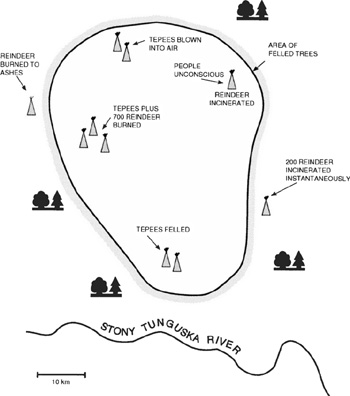
Surviving the Tunguska blast (After Gallant, 1994).
As is often true of disasters, many of the local people attributed a religious significance to the Tunguska impact. For example, following the explosion, local residents considered the region off-limits, a result of the wrath of Ogdy the fire god who had punished them for their disobedience. Travel through the region was subsequently forbidden.
The Earth as Cosmic Shooting Gallery
The Earth exists within a cosmic shooting gallery: impact-induced catastrophes have been part of its natural history for billions of years. As examples of some close calls, consider that in March 1989 a large asteroid passed within 100,000 km of Earth. Had it struck Earth, the impact would have been the equivalent of more than a million tons of exploding TNT and created a crater 7 km across. This asteroid is just one of thousands in Earth-approaching orbits. Amazingly, fewer than 80 Earth-approaching asteroids have been discovered to date, although sampling statistics imply that many more fly past Earth undetected. (Table 21.1)
Cosmic impacts occur throughout our Solar System. David Morrison of NASA-Ames Research suggests the best evidence for collision-induced catastrophes comes from the Moon’s battered surface. (If the Earth’s crust were not continually being eroded and pushed by underground geological activity, the face of our planet might more closely resemble the pitted Moon.) In fact, using the Moon to estimate the frequency and magnitude of impacts on Earth, the Earth endures an impact comparable to those that formed the five largest lunar mare craters once every 10 million years (see p. 216).
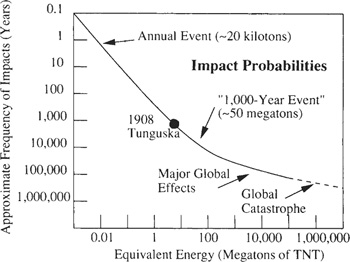
Impact probability energies, and frequency of occurrence. This plot indicates the chances our planet will be a hit by a member of the current population of Earth-crossing asteroids and comets. Notice that larger impacts are less common than smaller ones. Every year the odds are one in some hundred thousand of having a civilization-threatening impact. (After Morrison, 1990).
We can estimate the size distribution of impacts by counting the number of lunar craters in different sizes ranges. It turns out that the number of craters of a given size is roughly inversely proportion to the diameter squared (see p. 217). For example, craters 25 to 50 km across are about five times more common than those 50 to 100 km across. Also, the time between impact events of a given size varies directly as the diameter squared. A 1 km object strikes the earth about 100 times more often than those 10 km across. Even though larger impacts are more rare than small ones, such events can’t be avoided. Just look at the Moon. The cataclysm at the end of the Cretaceous destroyed most life on Earth. Most families of marine animals were wiped out, and there was widespread extinction of land animals and plants.
Table 21.1 Some of the larger Earth-crossing asteroids. Notice that most were discovered in the past 40 years.
Number |
Name |
Yr discovered |
Radius (km) |
Period (yrs) |
1685 |
Toro |
1948 |
2.4 |
1.60 |
2212 |
Hephaistos |
1978 |
4.4 |
3.18 |
4015 |
1979 VA |
1979 |
1.6 |
4.29 |
1864 |
Daedalus |
1971 |
1.7 |
1.77 |
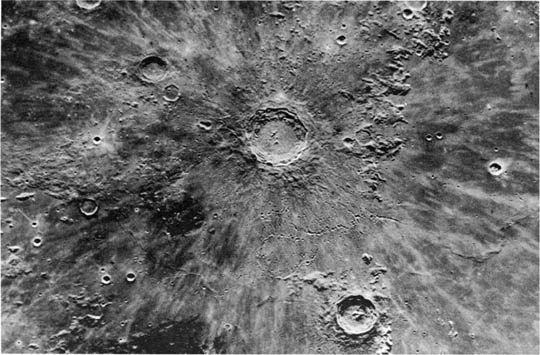
The lunar crater Copernicus and its surroundings in afternoon illumination. Examples of every type of lunar surface feature are shown on this plate taken with a 36-inch refracting telescope. (From Cherrington).
The figures on pp. 217 and 218 are my computer graphical simulations of a roughly 1/r2 distribution of craters. See the Appendix program code for details.2
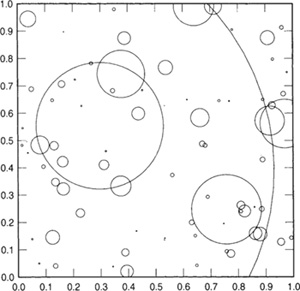
Computer simulation of crater size distribution.
What would happen if a comet were to hit the Earth? For one thing, the comet would be travelling at tens of kilometers per second and would be vaporized upon impact. Even if just one percent of the excavated Earth reaches the upper atmosphere, the entire Earth would soon be covered by a fine layer of dust several centimeters thick. The Earth would become a dark world. In addition, a large impact could actually blow away part of our atmosphere. If the strike occurs in the ocean, huge tsunamis would be produced. Acid rain would result from chemical reactions catalyzed by the comet passing through the atmosphere.
Strangely, there is a good side to cometary impacts. Without impact-generated diversification of animals, there might be less opportunity for development of life as new species evolve from survivors. If the dinosaurs did not die out, humans would not exist.
A Note on Swift-Tuttle
Because of the impossibility of accounting for the microdynamics of the comet’s motion, we don’t know how any error in the predictions will propagate.
—Brian Marsden, Sky & Telescope, 1993
I’m intrigued that the possibility of a strike by Swift Tuttle—admittedly remote—should arise at a time when there is unparalleled international interest in defending ourselves against just such a threat.
—Brian Marsden, Sky & Telescope, 1993
The Swift-Tuttle comet is discussed in Chapter 11. As author Brian Marsden notes, depending on the size and density of the comet’s nucleus, which we don’t know, such an encounter could precipitate the end of human civilization through nuclear winter scenarios. On the remote possibility that the comet plummets to earth sometime around August 14, 2126, jets of dust spreading tens of thousands of miles will engulf the Earth and the Moon.
Asteroid Impact Simulations
And the stars of heaven fell unto the earth, even as a fig tree casteth her untimely figs, when she is shaken of a mighty wind.
—Revelation, 6:13
As mentioned in other sections, there are many asteroids in orbits which intersect the orbit of the Earth. From where do these harbingers of doom come? How large can they be?
Within the asteroid belt between Mars and Jupiter fly asteroids like Ceres and Pallas, 480 and 300 miles in diameter. Some scientists believe that all the fragments in the asteroid belt are the remains of a planet that either broke up or somehow failed to be born. A few large asteroids have escaped from the belt, and all of these escapees have been given masculine names, usually after Greek gods and heroes. For example, in 1968, asteroid Icarus set off a Doomsday scare when it came close to the Earth. If it hit, it would have been the equivalent of 7000 100-megaton thermonuclear bombs. On October 39,1937, asteroid Hermes (see p. 219) nearly collided with the Earth, coming within a mere 485,000 miles—twice as far away as the moon.
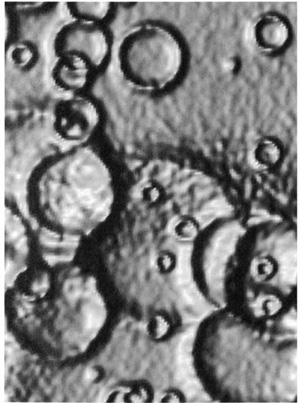
Three-dimensional computer graphics simulation of lunar craters.
About 130 impact craters have been discovered on Earth. For example, one large crater in Arizona is 4000 feet in diameter and 600feet deep. Scientists believe the crater was created 50,000 years ago by an asteroid about 80 feet in diameter weighing about 10,000 tons.
I recently used computer programs to simulate the effect of different sized asteroids colliding with the Earth. The following results come from Discover Space software created by Broderbund Software(1993). The program allows users to enter values for asteroid diameters and impact velocities, and then view the resultant carnage when the asteroid slams into the Earth. I have chosen a range of numbers to give you an indication of a variety of outcomes. In the following table, we consider 6 asteroids, A through F, having different diameters and impact velocities.
|
Asteroid Diameter (km) |
Impact Velocity
(km/sec) |
Crater Size |
Explosive Yield |
A |
0.1 |
2 |
.5 km |
43 Hiroshima
bombs |
B |
1 |
20 |
21 km |
4.4 million Hiroshima bombs |
C |
1 |
40 |
31 km |
17.5 million Hiroshima bombs |
D |
10 |
30 |
201 km |
9.9 billion Hiroshima bombs |
E |
20 |
20 |
292 km |
35 billion Hiroshima bombs |
F |
20 |
40 |
439 km |
140 billion Hiroshima bombs |
Asteroid A. The impact of a small, slow-moving asteroid, as in scenario A, would create damage equivalent to the detonation of a thermonuclear warhead. (The asteroid’s mass of 1.8 million metric tons, equal to a coal train 173 miles in length, would have an explosive yield of 876 kilotons of TNT.) If such an asteroid were to plunge into the headquarters of the Internal Revenue Service in Washington, D.C., none of the buildings from the White House to the Capitol Building would be left standing. Such an impact would flatten everything for miles and kill thousands.
Asteroid B. An asteroid of the size and velocity in scenario B is expected to hit the Earth once every thousand years, throwing rocks, dust, and water vapor high into our atmosphere. (The asteroid’s mass of 1.8 billion metric tons, equal to a coal train 173,000 miles in length, would have an explosive yield of 87 thousand megatons of TNT.) If such an asteroid plunged into San Francisco, the entire Bay Area would be destroyed and the San Andreas fault could be triggered by the shock. All humans within hundreds of miles would be killed by the overpressure blast of the shock wave and by radiation produced by a plasma sheet during atmospheric entry.
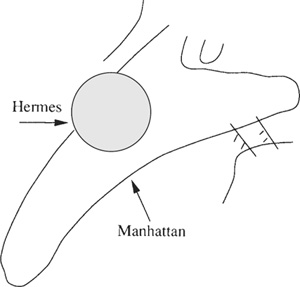
Schematic illustration showing comparative size of the meteoroid Hermes, and Manhattan Island.
Asteroid C. Like Asteroid B, Asteroid C is expected to hit the Earth roughly once every thousand years and would throw rocks, dust, and water vapor high into our atmosphere. (The asteroid’s mass of 1.8 billion metric tons, equal to a coal train 173,000 miles in length, would have an explosive yield of 350,000 megatons of TNT.) See Asteroid B description for lethal effects.
Asteroid D. The impact of an asteroid as in scenario D would produce a global catastrophe beyond our wildest imaginations. (The asteroid’s mass of 1.8 trillion metric tons, equal to a coal train 173 million miles in length, would have an explosive yield of 197 million megatons of TNT.) If such an asteroid plunged into Earth, our climate would change due to the large amount of water vapor, dust, and nitric acid blasted into the air. Earthquakes would be set off around the world, and ejected rocks and molten lava would rain down upon the cities. An impact of this type may have been responsible for killing the dinosaurs 65 million years ago. Another mass extinction occurred 250 million years ago and ended the Permian era. This extinction was even more devastating than the impact that wiped out the dinosaurs and may have been impact triggered. Impacts have come uncomfortably close to sterilizing our planet of larger life forms on a number of occasions in our past.
Asteroid E. This asteroid would have an effect similar to Asteroid D. (The asteroid’s mass of 14.7 trillion metric tons, equal to a coal train 1.4 billion miles in length, would have an explosive yield of 701 billion megatons of TNT.)
Asteroid F This asteroid would also have an effect similar to Asteroid D. (The asteroid’s mass of 14.7 trillion metric tons, equal to a coal train 1.4 billion miles in length, would have an explosive yield of 2.8 billion megatons of TNT.) Shown below is the crater size produced by this asteroid superimposed on the state of New Mexico.
Impact velocities higher than those listed in the table are likely for many asteroids. Note also that if an object with a 100-mile diameter slammed into the Earth, it would dig a crater the size of the Pacific Ocean. Could such a collision have created the Pacific Ocean basin early in the Earth’s history?
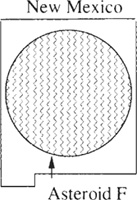
The crater size produced by Asteroid F superimposed on the state of New Mexico.
COMETS AND GODS
Cod protect us from the Comet and the Fury of the Norsemen.
—Medieval prayer
When beggars die, there are not comets seen; The Heavens themselves blaze forth the death of princes.
—Shakespeare, Julius Caesar
In 1910 the appearance of Halley’s comet (see p. 221) caused quite a stir, and some group predicted it would destroy the Earth. (The Earth, in fact, did pass through the gaseous tail of the comet.) One Englishman with an entrepreneurial spirit sold comet pills—a mixture of aspirin and sugar—to ward off the effects of the poisonous gases. Pseudo-religious cults briefly developed as local groups banded together to commiserate about the End of the World.
Throughout history, comets and God have always gone hand in hand. To Christians and Moslems of the Middle Ages, comets were usually considered examples of God’s wrath. Consider the following listing of comets I found in a medieval Christian document that linked comets to the Devil:
Anno 1531, 1532 and 1533 [comets] were seen, and at that time Satan hatched heretics.
In A.D. 69, Jewish rebels in the city of Jerusalem looked up into the sky and saw a comet. At the time, the rebels were fighting a difficult battle against the Romans who were trying to retake the city. Unfortunately for the Jews, their prophets urged them to climb the roof of the Temple to see the miraculous sign of their coming deliverance by God. The Jewish prophets were in error: The city was captured by the Romans the following year, and the holy Jewish temple was burned. Would the battle have had a different outcome if the Jews had not attributed a religious significance to the comet?
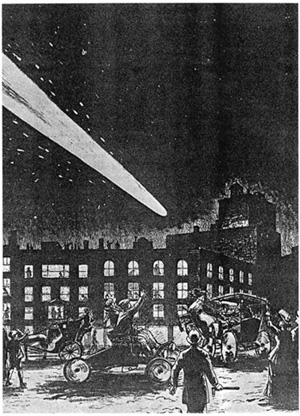
Drawing of Halley’s Comet in 1910.
COMET ANATOMY
If we were to send Mr. Plex with his strong diamond body out into space to explore the interior of a comet, what would he find? For one thing, the central body of a comet is like a dirty iceberg containing frozen methane, ammonia, and perhaps water. Embedded in the gasses are small, solid, stonelike particles. Here are some other facts:
• |
Comets melt away through time, fading after a few thousand years. When a comet’s tail passes by Earth, we encounter some of the small bits of solid material causing a meteorite shower.3 |
• |
We have nothing to fear from a comet’s tail. There is more material in a cubic inch of air above a Manhattan street than there is in 2000 cubic miles of a comet’s tail. |
• |
The main body of an average comet is 1.2 miles in diameter. Very large comet bodies can be many hundreds of miles in diameter, and if such a comet hits the Earth the results would be catastrophic. Lucky for us, the probability of such a comet hitting is low, once every 100 million years. |
• |
Like our own planet, comets orbit around the sun. Unlike the Earth, a comet’s orbit is usually less regular and often travels far beyond the orbit of Pluto. Comets generally have quite long orbital periods. For example, Comet Encke has the shortest orbital period of any comet known: 3.3 years. |
The Black Stone: A “Bomb from Heaven”
The bay-trees in our country are all wither’d
And meteors fright the fixed stars of heaven;
The pale-faced moon looks bloody on the earth
And lean-look’d prophets whisper fearful change, …
These signs forerun the death or fall of kings.
—Shakespeare, Richard II
It would be possible to test hypotheses of origin, such as, for example, the idea that some 5 million years ago, about the time of the origin of the hominids, the Kaaba was chipped off an asteroid named 22 Kalliope … and accidentally encountered the Arabian Peninsula 2,500 years ago.
—Carl Sagan, Broca’s Brain
Due to their sheer numbers, meteorites are much more dangerous to Earth than comets. Harvard Observatory estimates that 100 billion meteroids hit our atmosphere every day.
Meteorites were once considered “bombs” from heaven, and were often worshipped. Do you think the following biblical passage refers to them?
Men of Ephesus, what man is there who does not know that the city of Ephesians is temple keeper of the great Artemis, and of the sacred stone that fell from the sky? (Acts 19:35)
Meteorites have also been discovered in Aztec temples, and in North America they have been buried with the corpses of Indians. The oldest example of meteorite worship comes from one of the seven wonders of the ancient world: the Temple of Diana at Ephesus in Asia Minor. Residing in its exquisite Greek chambers was a black rock, probably metallic, an object from outer space.
In 1492, a 300-pound meteorite fell near the army of Emperor Maximilian who ordered that the stone be carried to his castle. His councilors declared that the meteorite was sign of God’s favor, and the Emperor had the stone hung in the parish church in Ensisheim.
Some scholars suggest that the Black Stone of the Kaaba in Mecca—the most sacred object in Islam—is a meteorite. In fact, stone worship was common in pre-Islamic Saudi Arabia. Arab merchants controlling lucrative trade routes also managed lucrative religious rituals that centered around the Kaaba and its sacred Black Stone.
The Kaaba today is a rectangular stone edifice (40 × 35 × 50 feet). The Black Stone is embedded in its southeast corner, five feet from the ground. The stone is actually made of a dark red material, oval in shape, some seven inches in diameter. In ancient days, many of its worshipers kissed the stone to show the depth of their feeling.4
FOUR RECIPES FOR A DOOMSDAY MACHINE
We have so far been discussing Doomsday brought about by natural causes. But what about Doomsday Machines? The term Doomsday Machine refers to the class of hypothetical weapons specially designed to destroy all large lifeforms including humans. Could such a weapon be produced? Sadly the answer may be yes. Here are four recipes based on the speculations of Daniel Cohen, author of Waiting for the Apocalypse:
1 |
Cobalt Bomb Cluster. The easiest Doomsday Machine to construct is the cobalt bomb cluster. Each cobalt bomb is an ordinary atomic bomb encased in a jacket of cobalt. When a cobalt bomb explodes, it spreads a huge amount of radiation. If enough of these bombs were exploded, life on Earth would perish. |
2 |
Wobble Bombs. In this recipe for Doomsday, large hydrogen bombs are placed at strategic locations on Earth and exploded simultaneously. As a result, the Earth may wobble on its axis. If placed at major fault lines, the bombs could trigger a worldwide series of killer earthquakes. |
3 |
Asteroid Bomb. This Doomsday device was actually suggested by Dandrige Cole, a speculator for the General Electric Corporation. He postulated it is possible to capture one of the larger asteroids and send it crashing to Earth by exploding nuclear bombs at specific locations on the surface of the asteroid. |
4 |
Botulis Bombs. Biological Doomsday Machines refer to biological weapons utilizing bacteria, viruses, or various biological toxins. For example, a few pounds of poison produced by the botulis bacteria is sufficient to kill all human life. |
Other Ways to Die
The universe faces a future extinction of endless cold or intolerable heat. The more the universe seems comprehensible, the more it also seems pointless.
—Steven Weinberg, The First Three Minutes
Some say the world will end in fire. Some say in ice …
—Robert Frost
Many believe that the Earth is like an inmate waiting on Death Row. Even if we do not die by a comet or asteroid impact, we know the Earth’s days are numbered. The Earth’s rotation is slowing down. Far in the future, day lengths will be equivalent to 50 of our present days. The Moon will hang in the same place in the sky, and the lunar tides will stop.
In five billion years, the fuel in our Sun will be exhausted. The Sun will begin to die and expand, becoming a red giant. At some point, our oceans will boil away. No one on Earth will be alive to see a red glow filling most of the sky. As Freeman Dyson once said, “No matter how deep we burrow into the Earth … we can only postpone by a few million years our miserable end.”
Where will humans be, five billion years from now, at the End of the World?5
Even if we could somehow withstand the incredible heat of the Sun, we would not survive. In about 7 billion years, the Sun’s outer “atmosphere” will engulf the Earth. Due to atmospheric friction, the Earth will spiral into the sun and incinerate.
Here is our future:
Sun expands to engulf the Earth . 7 billion years
Stars cease to form. All large stars have become neutron stars or 1 trillion years black holes.
Longest-lived stars use up all fuel. 100 trillion years
And when he opened the seventh seal, there was silence in heaven about the space of half an hour.
—Book of Revelations (8:1)
Is There Hope?
If this ending seems too dismal to you, perhaps we should ask if there is hope for humanity when the Sun expands to engulf the Earth in seven billion years. To give an answer, first consider that around four billion years ago, living creatures were nothing more than biochemical machines capable of self-reproduction. In a mere fraction of this time, humans evolved from creatures like Australopithecines. Today, humans have wandered the Moon and have studied ideas ranging from general relativity to quantum cosmology. Once space travel begins in earnest our descendents will leave the confinement of Earth. Because the ultimate fate of the universe involves great cold or great heat, it is likely that Homo sapiens will become extinct. However, our civilization and our values may not be doomed. Who knows into what beings we will evolve? Who knows what intelligent machines we will create that will be our ultimate heirs? These creatures might survive virtually forever, and our ideas, hopes, and dreams carried with them. There is a strangeness to the loom of our universe which may encompass time travel, higher dimensions, quantum superspace, and parallel universes—worlds that resemble our own and perhaps even occupy the same space as our own in some ghostly manner. Our heirs, whatever or whoever they may be, will explore these new regions of the loom. They will explore space and time. They will seek their salvation in the stars.
I conclude on an upbeat note from theoretical physicist Freeman J. Dyson
Goedel proved that the world of pure mathematics is inexhaustible; no finite set of axioms and rules of inference can ever encompass the whole of mathematics; given any finite set of axioms, we can find meaningful mathematical questions which the axioms leave unanswered. I hope that an analogous situation exists in the physical world. If my view of the future is correct, it means that the world of physics and astronomy is also inexhaustible; no matter how far we go into the future, there will always be new things happening, new information coming in, new worlds to explore, a constantly expanding domain of life, consciousness, and memory.









